
Mole crickets are members of the insect family Gryllotalpidae, in the order Orthoptera. Mole crickets are cylindrical-bodied, fossorial insects about 3–5 cm (1.2–2.0 in) long as adults, with small eyes and shovel-like fore limbs highly developed for burrowing. They are present in many parts of the world and where they have arrived in new regions, may become agricultural pests.

Cerura vinula, the puss moth, is a lepidopteran from the family Notodontidae. The species was first described by Carl Linnaeus in his 1758 10th edition of Systema Naturae.
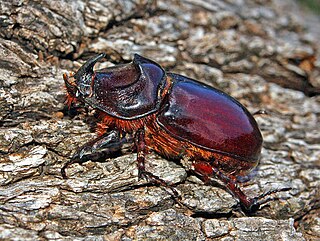
The European rhinoceros beetle is a large flying beetle belonging to the subfamily Dynastinae.
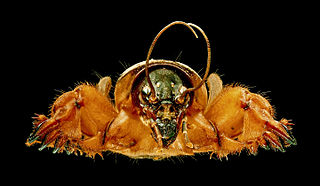
Gryllotalpa gryllotalpa, commonly known as the European mole cricket, is widespread in Europe and has been introduced to the eastern United States. The scientific name is 'mole cricket', derived from the Latin 'gryllus' (cricket); and 'talpa' (mole), because of the fine dense fur which covers it and its subterranean habits, and because of the mole-like forelegs adapted for digging, a good example of convergent evolution.

Volucella zonaria, the hornet mimic hoverfly, is a species of hoverfly. These flies are capable of buzz pollination.

Eristalinus taeniops is a species of hoverfly, also known as the band-eyed drone fly.

Larra, also known as mole cricket wasps or mole cricket hunters, is a genus of wasps that prey on various species of mole crickets. They have gained prominence as integrated pest management agents.

Sirex juvencus is a species of horntail found in Europe, Siberia, Sakhalin Island, Japan, the Philippines, Algeria and several other countries. Its common name is steely-blue wood wasp because of its color.

Trabala vishnou, the rose-myrtle lappet moth, is a moth of the family Lasiocampidae. It is found in southern Asia, including Pakistan, India, Bangladesh, Thailand, Sri Lanka, Myanmar, Java, China, Japan, Taiwan, Hong Kong, Vietnam and Indonesia. Four subspecies are recognized.
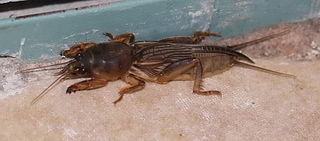
Gryllotalpa orientalis is a species of mole cricket in the family Gryllotalpidae, commonly known as the oriental mole cricket. It is found in much of Asia and Australasia. At one time, this species was misidentified as G. africana and thought to have a widespread distribution in both Africa and Asia, but in the 1980s, G. orientalis was recognised as a separate species. It is a polyphagous pest, damaging crops by gnawing their roots.

Lygus pratensis is a species of plant bug belonging to the family Miridae.

The hairy-footed flower bee is a species of bee belonging to the family Apidae.

Gasteruption jaculator is a species of the family Gasteruptiidae, subfamily Gasteruptiinae.
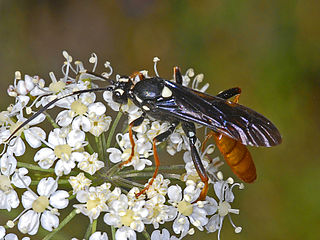
Amblyjoppa fuscipennis is a species of the parasitic wasp in the family Ichneumonidae. It was first described by Constantin Wesmael in 1844.

Anomalon cruentatum is a species of parasitoid wasps belonging to the family Ichneumonidae.
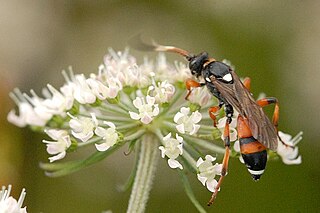
Ichneumon sarcitorius is a species of wasp belonging to the family Ichneumonidae subfamily Ichneumoninae.
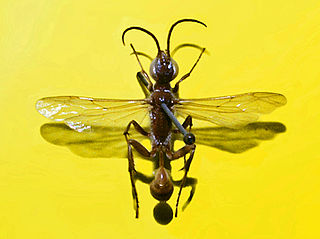
Chalybion flebile is a species of mud dauber wasps belonging to the family Sphecidae.
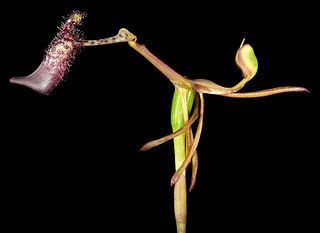
Drakaea livida, commonly known as warty hammer orchid, is a species of orchid endemic to the south–west of Western Australia. It is pollinated by a single species of male thynnid wasp using sexual deception. The orchid's labellum is similar in shape and scent to a flightless female thynnid wasp. Although the species was formally described in 1842, the description was often later overlooked and other hammer orchids were given the name Drakea livida. It is now known to be, along with Drakaea glyptodon, one of the most widespread of the genus.
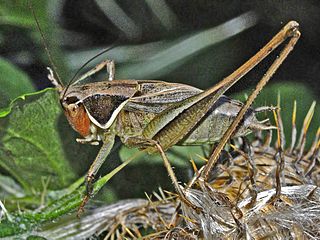
Sepiana sepium, common name sepia bush-cricket, is a species of bush crickets belonging to the subfamily Tettigoniinae and tribe Platycleidini. It is the only species within the monotypic genus Sepiana.




















